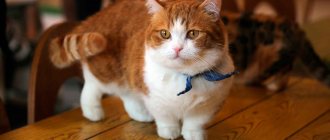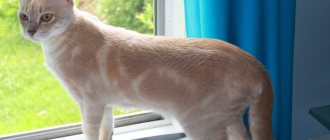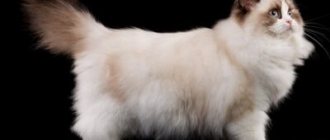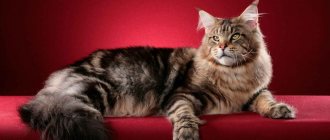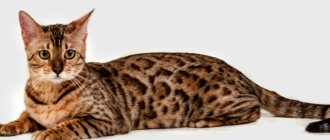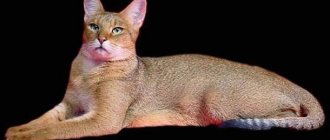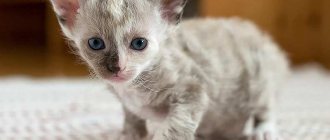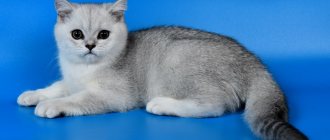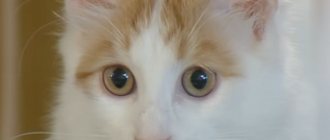Cat breeds with tufted ears are in demand. Many are looking for certain species and are willing to pay significant money, sometimes even a fortune, for such gorgeous animals. They are beautiful, graceful, friendly, and over time, such pets become members of the family.
Cats with long hair usually have ear tufts. The distinctive breed characteristic of a cat is more pronounced at an early age. As they grow older, the tassels become invisible.
The significance of tassels for wild animals has not been clearly established.
Experts have different points of view on this matter.
- The first version is that the brushes play the role of an amplifier of sound waves. With their help, the animal quickly determines the source of sound, catches minor rustles and voices of rodents hiding underground or in snow cover.
The brushes help to catch the sounds of an approaching enemy at a distance of several kilometers.
This version is considered not very true, although there is an opinion that without brushes a cat hears worse.
- Another theory suggests considering the tassels as a beacon, with the help of which animals can see each other from a distance.
- The third version claims that tassels are indicators of a cat's maturity. Their length determines the age and experience of the animal.
Today, a special place in the list of popular pets is occupied by a breed of cats with tufted ears.
Cats with tassels on their ears, while maintaining a formidable and warlike appearance, have actually acquired the ability to get along at home and become a friend and favorite of a person.
Maine Coon
This breed is a semi-long-haired cat. The breed was bred in the USA, and is one of the largest purebred representatives in the world, created to live next to humans. This is a large breed of cat, with an extraordinary appearance, a variety of colors and an affectionate character.
The Maine Coon first appeared in Northeast America, in the state of Maine, about a hundred years ago. Part of the animal's name is associated with this area. The second component of the name in translation means raccoon or lynx, which is explained by the similarity of the fur coat with the coat of a raccoon. And with the presence of tassels, cats resemble a lynx.
The breed developed in northern climates, which explains the appearance of wide bones and long hair between the pads on the paws. Size does not match weight. Males weigh more than 10 kg. This breed of tasseled cats entered the Guinness Book of Records thanks to an amazing specimen weighing 16 kg.
Character
The Maine Coon is distinguished by its character and interesting features:
This ear-tufted cat adores her family and doesn't require much attention herself. They do not like loneliness; if you have to leave her alone for a while, you need to purchase various toys for the cat so that she does not get bored before the owners arrive. They love water and water procedures very much. There should always be a bowl of water next to the food for your pet to splash into. Maine Coon is able to communicate using different sounds. In addition to meowing, they make sounds similar to squeaks and trills. They have developed body language. If a cat wants to express a special reverent attitude, it hits its head. The breed is adapted to living in any climatic conditions. They can withstand winter cold and snowy weather without problems. Very friendly. The color of cats of this breed with tufted ears varies in 75 different color combinations. The breed includes both ginger cats and individuals with a chocolate color; lilac-colored specimens are possible, although these variations are recognized as a deviation from the standard and are not the norm for this species.
Maine is a coon with a half-meter tail, long hair, wide strong paws, powerful muscles and a large head. The cat's head is elongated, high cheekbones, triangular ears with tufts. The eyes of Maine Coon cats are oval-shaped, the color should be in harmony with the coat.
Care
Caring for this breed is easy:
- The coat needs to be brushed daily; Provide her with a scratching post;
- For food and water you need to place separate bowls, preferably made of glass or stainless steel;
- It has a tendency to develop periodontal disease; to prevent the disease, you need to regularly brush your pet’s teeth.
- The animal should be provided with its own corner, as it needs privacy from time to time. When the cat is in its corner, you should not touch it, so it will feel safe.
- It is recommended to feed the Maine Coon dry food, which will keep the teeth in good condition.
You can add to your diet:
- Raw beef;
- Cottage cheese;
- Quail eggs;
- Boiled chicken.
The Maine Coon is a breed of cat with tassels, included in the list of the most expensive species in the world ($4,000 to $80,000).
How much does a live domestic lynx cost in Russia?
There are many species of wild cat. Let's look at the prices for the main ones.
- Red lynx, or red – 50 thousand rubles.
- Canadian – 40 thousand rubles.
- Ordinary – 100 thousand rubles.
- Pyrenean, or Spanish - it is not possible to buy legally, as it is listed in position 1 of CITES.
Meanwhile, wild species are difficult to domesticate. Thanks to crossbreeding, breeds have been developed that are characterized by a gentle disposition and good tamability. Naturally, this could not but affect the price aspect.
- Steppe lynx, or caracal – 400 thousand rubles. Due to the noticeable external similarity, this animal was classified as a lynx species, but today it belongs to a separate genus. If raised correctly, these kittens turn into playful and friendly adult pets.
- Karaket – from 850 thousand to 1 million rubles. This species was the result of mixing a domestic cat with a caracal. This is a rather peaceful, friendly breed, sometimes very independent, but not at all aggressive. A hybrid belonging to the first generation is more valued, the cost of which often exceeds 1 million rubles. By the way, the caracat is more similar to the lynx.
- Domestic lynx - from 400 thousand to 1 million rubles. These representatives are a cross between a domestic cat and a Canadian lynx. In appearance it is similar to its wild ancestor, but from the domestic cat the lynx got its active character, tenderness and love for humans.
Keeping such pets does not require a huge amount of space, and there are no risks associated with living with a wild animal. For how many rubles you can purchase such representatives, we will consider further.
- Siberian cat – from 7 to 15 thousand rubles. This little beauty was the result of a love for wild cats that lived in the Trans-Urals and oriental breeds. The thick coat is due to the harsh climate. The tassels on the ears resemble wild relatives. A characteristic feature of this breed, in addition to its complacent disposition, is attachment to only one owner.
- Norwegian forest - from 12 to 70 thousand rubles. and more. Their large size and powerful stature should not frighten you, because these Norwegian cats have a kind and reserved disposition. By the way, they are ready to get along with noisy children and with other tribesmen, for example, with dogs.
- Pixie bob – from 30 to 100 thousand rubles. This breed is quite young and rare. These cats have a canine character, are very smart, and calm. They tolerate change negatively, and without human contact they can quickly become wild.
- Maine Coon - from 20 to 80 thousand rubles. One version says that such pets were the result of mating between an ordinary cat and a North American lynx.
- Kurilian bobtail – from 15 to 70 thousand rubles. These wonderful animals were bred on the Kuril Islands. This breed is perfect for someone who is looking for a fun and smart animal.
- American bobtail – from 35 to 90 thousand rubles. This species is very loving, characterized by ingenuity and intelligence. For example, these cats will have no difficulty leaving a closed cage.
Norwegian forest cat
Officially, the World Cat Federation registered this cat with tufted ears in 1970. Norway is recognized as the birthplace of the breed. Amazing and strong animals stand out from other pets.
Peculiarities
The breed is quite special; the Norwegian Forest has a number of specific characteristics;
Thick coat with water-repellent wool; Massive but flexible skeleton, elongated body, powerful muscles; Large triangular head; The ears are large, with tufts on the edges; The paws are oval, the limbs are high, there are woolen brushes between the phalanges; The eyes are large, round in shape, the color matches the coat; The tail is straight, fluffy, reaching the shoulder girdle; This cat with tassels on her ears is the owner of whiskers that stick out in different directions;
Character
The Norwegian Forest is a tasseled cat breed that is a combination of a wild hunter and a cute pet. They have a lot of wonderful character traits:
Patient and reserved. They can play with children for hours; Get along well at home; Easy to train; They love to sleep, but when they wake up they play and hunt happily; Freedom-loving, they prefer to walk in the fresh air, and therefore such cats need to be kept in large apartments or in private houses. If a Norwegian cat lives at home, you need to protect poultry and rodents from him, because they are born hunters.
Small kittens of the Norwegian cat look like balls and you can hold them in your hands for hours. But an adult forest animal will not tolerate this. They can lie down next to the owner, they will allow you to pet them, but only when it is pleasant for them too.
Care
This breed is very hardy, with good health. They rarely get sick, are not afraid of cold weather, and are the longest-livers among other species. They love active games.
Has no special requirements. You need to regularly walk on a leash, have vaccinations and examinations by a veterinarian, provide adequate nutrition, and brush daily.
If they don’t like something, they won’t take revenge; they’ll just leave home!
Norwegian cat
It has been officially known since the 16th century, but judging by the fact that it is sometimes named among the possible ancestors of the Maine Coon and is associated with the Vikings, it appeared alongside humans long before the first mentions in sources. In some sagas, for example, you can find a mention that the god Thor was always accompanied by a certain “fluffy forest beauty”, whose description is very similar to a Norwegian cat.
Be that as it may, the owners of livestock farms knew this cat very well. After the Second World War, it was on the verge of extinction, so even some special measures were taken, supported by local authorities, to ensure that this species did not completely disappear into the darkness of History. The measures turned out to be effective, and today this cat is quite common not only in Scandinavia, but also in other countries of the world.
It is valuable and attractive to lovers of all things feline for many reasons, and above all for the following:
- a beautiful fluffy coat with a water-repellent layer and a thick undercoat, which allows its owner not to freeze. Of all the variety of colors allowed in the breed, four types are most often found - black, red, gray and white.
- large sizes. The average weight of a Norwegian cat reaches 6-8 kg.
- good health. It has been noticed that these cats can live to old age without ever getting sick.
- patience, gentleness and friendliness. Like all cats in the world, they love affection, but for some reason they do not like to sit on laps.
- activity and mobility. It's rare to see a Norwegian cat lying imposingly on the sofa. Basically she is always on the move. She loves various games, especially those simulating hunting: this is how her hunting instinct manifests itself.
- longevity. There is evidence that cats of this breed can live up to 20 years or more.
- sociability, dignified behavior, the ability to get along with other animals and lack of conflict.
- pronounced love for children.
As an interesting fact, it can be noted that the notorious tassels on the ears of the “Norwegians” are weakly expressed.
Norwegian Forest Cat
Pixie - bob
Quite a rare breed of cats with tassels. Reminds me of a lynx. The pet easily gets along at home, it can be easily trained to obey commands and taken for walks on a leash. They love to walk in the fresh air.
They love to talk and therefore meow a lot.
This breed with tufted ears has a soft, unobtrusive and affectionate character. The only thing they require is contact with a person, without this the animal will go wild.
Pixie Bob has a large build, strong paws and a short tail. The breed's coat is soft and can be either short or long. The muzzle has a chin and plenty of fur.
Highlander
A new breed, the Highlander, also has round ears. These are very unusual animals of an exotic species, which also have the name “mountain lynx”. However, among the ancestors of these cats there were no dangerous predators; their ears are slightly curved back, and their muzzle in its expression resembles a trot. The distinctive features of the breed are:
- Powerful muscular body.
- Short tail.
- The eyes are large and round in shape.
- The acceptable colors are varied, the standard recognizes the presence of 1-2 colors, as well as color point colors.
Cats with round ears are diverse, among them there are long-haired and short-haired, large, medium and small in size, but they all look bright, unusual and attractive.
Chauzie
The breed is the result of crossing an ordinary cat and a jungle cat.
Character
Shawzis are lovers of active games. They cannot stand loneliness. They willingly participate in all the affairs of family members. They are strong friends with children and can play with them for hours. Very curious and can leave the house through the window, you should be more attentive to her.
Breed characteristics and care
Chausie has short hair and a thick undercoat; The color of the animal can be silver, gold, black. Shausi's physique is strong, his muscles are well developed, his limbs are long, his paws are of medium size; The ears are large. Closer to the base they are wide, the edges are narrowed with tassels; The eyes are slanted. Specimens with light green and amber eyes can be registered in the breed; This breed only needs to be brushed during the shedding period.
Caraquet
A large, well-built muscular cat on high legs, with a neat, slightly elongated head, large ears, wide at the base, a pleasant expression of a rounded muzzle and large almond-shaped eyes. The Caracat has a short, smooth, close-fitting coat of warm shades. This is a balanced, inquisitive and sociable cat.
Caracats are hybrids; they are descendants of a domestic cat and a steppe lynx (caracal). It is disproportionately more difficult to breed a breed based on hybrids of different species: you need to get wild animals from somewhere (and this is a lot of money), the offspring are often non-viable and infertile, the desired traits are not fixed as quickly as we would like. Today, selection work on breeding caraquets is in full swing, and they are not yet recognized by any of the felinological systems.
No one planned to create this breed on purpose. It so happened that an ordinary outbred cat seduced a male caracal, an inhabitant of the Moscow Zoo. This mating did not go unnoticed, and most importantly, it was fruitless: the seductress gave birth to a kitten, which can be called the first representative of the breed. Caraquet breeding was carried out in different countries, including Russia. To date, the greatest success has been achieved by the Russian breeder I. Nazarova.
It should be noted that the ears of many representatives of long-haired breeds (and long-haired cats in general) also have small tassels. But short-haired cats usually lack this feature.
Caracal
This graceful and majestic animal is an inhabitant of Asia and Africa. Translated, the name of the breed means “black ear”. This cat with tassels on her ears has sharp eyesight and sensitive hearing. The paws are powerful, the body is strong. When hunting in nature, she is able to catch prey larger than herself. The animal is wild; people tried to tame it back in Ancient India and Persia. The purpose of taming was to use the animal for hunting.
Today, a tamed caracal costs from $10,000 and is a sign of wealth among wealthy people who value exotic things.
This wild cat with tassels on her ears behaves very sweetly and friendly at home. However, it is not recommended to have it at home where small children live.
Characteristic indicators
The color of the animal is reddish-sandy or sandy. The tassels and outer side of the ears are black.
Body length is about 80 cm, tail up to 30 cm, shoulder height 45 cm, weight reaches up to 20 kg. The fur is short and thick.
Features of maintenance and care
It is better to buy a kitten at 6 months; at this age, the predator quickly adapts to others; You need to know that the caracal does not tolerate rudeness and punishment; In a caracal, fun and attacks of aggression can alternate; you need to be prepared for such a course of events, regularly consult with specialists; It is better to keep a caracal in a private house with a high fence; Your pet's claws need to be trimmed periodically with special scissors; Basically, such animals are trained for the tray in the nursery and there are no special difficulties associated with this at home. They, like other cats, do not bury their excrement, but leave the contents of the tray on the surface; The animal does not tolerate cold well. A lover of water treatments; A caracal should be combed no more than once a week using a furminator. You should bathe when the cat is very dirty. A properly raised caracal will become not only a good friend, but also a reliable guard for the home.
Lynx-like felines that can live with humans
Lynxes are not the only representatives of the family with long hairs on their ears and camouflage coat color. Among wild relatives, caracals and jungle cats have the greatest external resemblance to the famous predator. They also live in the wild, but can live with humans. However, for their maintenance it is necessary to create conditions close to the natural environment.
Caracal - steppe lynx
The caracal is called the steppe lynx. Wild caracals are found in Africa, Central Asia, the Middle East, and in some areas of Turkmenistan, Kyrgyzstan, Uzbekistan and Dagestan.
Caracal
Caracals have a slimmer build and weigh 11–12 kg. The tall, straight ears have distinct, long dark hairs. The steppe lynx's fur is dense, short, and has hard bristles on its paws. A distinctive feature of the caracal is its reddish coat without spots. In addition, the animal has a fairly long tail, growing up to 30 cm.
Baby caracals
Kittens born in the wild will not be able to become pets. Only animals born from individuals kept in captivity can live with humans. It is better to keep domesticated caracals on the territory of country houses, where they will have the opportunity to move freely over a large area.
When keeping a caracal at home, special attention should be paid to nutrition. A predator's diet must include raw meat, poultry, and eggs.
Some owners of these exotic pets feed them premium or super-premium dry ready-made food.
It is not recommended to have caracals in a house where there are small children.
A predator has very strong natural instincts, so if handled carelessly, it can quickly hit back at the offender.
Jungle cat - marsh lynx
People were able to tame the jungle cat 3 thousand years ago. The people of Egypt were the first to do this. They called it house, which meant "house", because the animals lived in people's houses. Another nickname for the animal is the swamp lynx. These animals do not like to go out into open areas. They live in reed thickets, among bushes growing on the banks of water bodies, and often hunt for fish and waterfowl. Animals visit human settlements only when there is a lack of food. They raid chicken coops.
jungle cat
Populations of these predators are mainly found in regions with warm climates. They live in Africa, Central Asia, the Caucasus, and also live in India, Palestine, and Thailand. In Russia, animals can be seen on the Volga coast and in Dagestan.
This predator is similar to a lynx in the color of its coat, but is smaller in size. The body length of the jungle cat is about 90 cm, the weight of the largest individuals reaches 12 kg, the height at the withers does not exceed 0.5 m. Small spots on the body are almost invisible in adult individuals, they are more pronounced in kittens.
The jungle cat becomes a pet only in exceptional cases. Developed natural instincts make it dangerous even for the owner who has lived nearby since childhood.
You can keep a swamp lynx in an area where it can freely hunt, swim and walk. The proximity of other pets to a wild cat is unacceptable.
Siberian cat
Ancestors of the Siberian cat from Taiga. The breed was officially registered in the 80s. Today, most of these furry animals live abroad.
This breed is classified as semi-longhaired. The tufts on the ears of Siberians can be clearly defined or not visible at all.
The physique of Siberian cats is massive, the limbs are distinctly strong. The head is trapezoidal, round, of medium size. The weight of a Siberian cat is about 6 kg. Cats can weigh up to 12 kg.
The tail is wide. The eyes may be yellow or green.
Color - gray, with brown and black weaves.
The peculiarity of the breed is that they take a long time to mature. Their period of maturity begins at 5 years.
Character
The breed of these cats with tassels on their ears is considered one of the "universal" ones.
Their character is strong, but at the same time they are affectionate and friendly. Affection is always welcome.
It gets along well both in a private house and in an apartment, as the breed is very neat, with a high sense of tact.
They get along great with children. They will be friends with other animals living at home. They do not tolerate rodents. Its prey can be a rabbit or a ferret living together in the house.
The Siberian cat is fearless. She may not let a stranger into the house, warn the owner about the approach of people who seem suspicious to her.
He loves to give gifts to his owner, sometimes bringing home something in his teeth.
The breed loves to climb high objects and play with toys. Smart like no other breed. Before doing anything, he thinks about the correctness of the action.
Thanks to the specificity of wool, they relieve pain caused by osteochondrosis.
Care
Siberian cats love walks and can walk outside even in winter; It is better to feed the breed natural food, with vitamin supplements; You need to regularly clean the animal’s ears with oil-based cotton balls, and its eyes with just damp ones; They are in good health, but require all prescribed vaccinations. Tassels are evidence that they are carriers of the genes of their wild counterparts, and therefore, when purchasing such a breed, you need to be prepared to give your pet personal space. Such cats are distinguished by intelligence and loyalty, they are freedom-loving, they like walks in the fresh air. They demand respect in return for their devotion and love. Having fallen in love with their owner, cats of this type will take on the responsibilities of his protector!
Bassed Hound
In some ways, this breed is similar to a beagle, but with longer ears, a phlegmatic character, and a slightly longer body.
These 33-38 cm in height and 20-29 kg in weight are full of greatness and a kind of “pathos”, if one can say so about a dog. Like many other beloved small dogs, they are hunters. A few hundred years ago, Basseds were used for collective fox hunting. Basseds do not show aggression and are excellent nannies; they can make friends with some pets, with the exception of rabbits and rodents (they will immediately become prey).
Despite their kindness and phlegmatic nature, they have a stubborn character and can often drive their owners crazy; they are also difficult to train.
Bassed dogs are also more likely to develop various ear diseases. So, if a dog often scratches its ear, then it is most likely either an infection or a mite.
Pixiebob
Another artificially bred breed comes from the USA. It was created as a domestic cat, similar in appearance to a wild lynx. The name is English and translates as “short-tailed elf.”
The first pixie-bob, a girl named Pixie, was born to two outbred, but very unusual cats. Their owner, Carol Ann Brewer, lived in Washington and was a professional cat breeder. She acquired the two above-mentioned animals a year apart. The first kitten was purchased in 1985. Its uniqueness was its short tail and six toes. She got the second animal as an adult. Its tail was also short, and the cat was also large in size - its weight was eight kilograms, and the animal was severely emaciated.
Pixie was born with dark spots on a light red background. And its predatory muzzle in shape and expression was very reminiscent of a lynx. A year after her birth, Carol Brewer began breeding a breed of domestic lynx - pixiebobs.
Today, representatives of the Pixiebob breed are distinguished by the following standards:
| Sign | Description |
| Weight | Cats - about 5 kg; cats - up to 10, on average - 8 |
| Body type | Massive. Body with well-developed muscles. The shoulder blades protrude slightly. The chest is wide, the hips are medium in width. Hanging belly |
| Limbs | Long, powerful. The front ones are slightly shorter than the rear ones. The pads are large and round. The fingers are large, their number can reach seven |
| Tail | Very short, but at least five centimeters in length |
| Neck | Thick and powerful |
| Head | Medium or large, shaped like an inverted pear. The muzzle is large, diamond-shaped. The chin is massive. Has sideburns like a lynx |
| Nose | Wide, somewhat convex |
| Eyes | Size - medium, shape - almond-shaped. Planted deep. Color - golden, brown or rich green. For kittens up to the seventh month of life - blue |
| Ears | Medium size, wide base. Set deep and slightly inclined forward. Rounded ends |
| Wool | Long-haired varieties have up to five centimeters, while short-haired varieties have short hair. Soft, thick, with abundant undercoat. Longer on the stomach than on the rest of the body |
| Color | Different shades of brown, red and gray colors, on top of which a design is superimposed. Inverted ticking is possible (the hairs are darker below and lighter at the top). A lighter tone is allowed on the chest, abdomen and neck |
Drawing on wool
The pattern on the fur of pissybobs has elements that are mandatory for cats of this breed:
- the end of the tail and paw pads are black or dark brown;
- the eyes are surrounded by a light ring: white or cream;
- dark stripes run from the corners of the eyes along the cheeks;
- on the forehead there is a characteristic pattern in the form of the letter “M”;
- the mustache can be multi-colored: dark at the base and white at the top;
- the entire body, including the stomach, is covered with small or medium-sized spots.
Character
Pixiebobs become very attached to their owner. They are loyal, but very jealous. Demanding of affection and attention. Quite obedient. They are easily accustomed to walking on a leash and harness. They are easy to train and can learn a fairly large number of commands.
Playful, active. They need the company of not only people, but also other animals. They get along easily with any pets and small children. But if a person devotes little time to his pet, conflicts may arise with him.
Content Features
Representatives of this breed live on average up to thirteen years. Their health is quite good, there are almost no hereditary diseases. But some experts believe that pixiebobs are prone to diseases of the genitourinary system. Also in the history of the breed, several cases of serious heart defects have been recorded, which can be transmitted genetically. Therefore, once a year it is recommended to check the cat with an ultrasound in order to notice the problem in time and avoid complications.
Representatives of this breed may experience a strong negative reaction to some vaccinations, so consultation with a doctor is required before vaccination. Pixiebobs are prone to obesity, so you need to carefully monitor their diet. Feed strictly twice a day with specially selected dry food, and in no case give more food than normal.
These cats need to be brushed every day. This applies even to short-haired varieties, since pixie bobs have very thick hair. Wash your cat as needed, no more than once a month. But you need to brush your teeth and ears regularly.
How to put ears on a dog
How to position the ears.
According to the standard of some breeds, the ears should stand up. This is not only an aesthetic requirement, but also a necessary condition for hygiene for many breeds. In order to meet the standards, the ears must be straight on the Boxer, East European Shepherd, Doberman, German Shepherd, Chow Chow, Laika, Yorkshire Terrier, Chihuahua and many others. In dogs of these breeds, the ears most often stand up on their own during tender puppyhood. But sometimes owners will need a whole range of special measures.
Sometimes the owner does not immediately pay attention to the existing problem: both ears are not working, or only one; It happens that the puppy’s ears do not straighten completely or are in an inclined position relative to the head. The sooner you can start correcting this defect, the faster you can resolve the issue, by the way, without making much effort
The sooner you can start correcting this defect, the faster you can resolve the issue, by the way, without making much effort.
You must clearly understand that with your inept and illiterate actions you can bring real trouble to a defenseless puppy: very often the ears are purposefully subjected to all sorts of tests, fixed in all sorts of ways, wrapped, glued. You can lead your experiments to serious complications, which only qualified veterinarians can handle in clinics.
In breeds in which the ears are not covered with continuous thick hair, special devices can be attached without special preparation
Toy terriers, for example, will not cause you any additional trouble, but the hair around the Yorkie’s ear must be carefully trimmed with scissors, both outside and below
Ear frame.
You can buy the right type of frame for your puppy at a pet store. Dogs definitely don’t like such designs. After some time, the puppy will most likely take it off. In the case where the ear is already standing without fastening, it is not necessary to reinstall it. Re-strengthening is necessary if the ear suddenly drops again after some time. In this case, we reinstall the dog's ears. Depending on the size of the ear, this procedure may need to be repeated several times.
If you decide to seal your pet’s ears yourself, use only special medical tape and glue for this. Do not attach the patch over the entire width of the ear, because then you can only remove it along with the delicate new fur. After inevitable injuries, irritation and dermatitis will appear on the skin.
Practical tips:
The patch should be no wider than 2 cm
Be sure to make several wide holes so that the skin can breathe. Very carefully remove the patch, and then treat the skin of the ear with zinc ointment. Breaks between procedures must be strictly observed. You should absolutely not keep the patch on for more than six days in a row.
Do not lubricate the ear with alcohol solutions under any circumstances. In some cases, a special massage is required; only a competent veterinarian can recommend it. Otherwise, you can only worsen the situation, and so much so that it will no longer be possible to correct it. If you have fixed ears, they need to be examined carefully every day. If you don’t do this and don’t correct the difficulties that have arisen in a timely manner, you can get otitis media. And in a sick dog, it doesn’t matter at all whether the ears meet the standards or not.
If you cannot solve the problem yourself, you will need advice and help from specialists.

